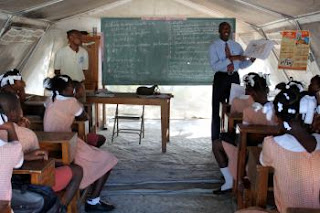 |
| Since the SOS Hermann Gmeiner School now teaches almost double as many children now as it did before the earthquake, some lessons are held in tents. - Photo: Hilary Atkins |
Before I left for Haiti I asked if some children at the SOS Hermann Gmeiner School in Nairobi could do some drawings about life in Kenya. The Nairobi children obliged and I carried their drawings across a continent and an ocean, careful to keep them flat. Yesterday Mr Myrtil, the school principal, and I showed them to a class of 12 and 13 year olds.
 |
| It turns out that being a child in Kenya was not that different from being a child in Haiti - until the earthquake changed everything. - Photo: Hilary Atkins |
The subjects were varied: some related to child rights – the right to education, to shelter, to play, etc. Others showed Kenya’s beautiful coast with its varied marine life. There was a drawing of a traditional thatched house, two of Kenya’s police working to catch criminals and an excellent depiction of urban housing complete with high walls and barbed wire, which is not so different to Port au Prince. Two more showed cattle in Kenya and I explained that cattle and wealth usually go together – not so in Haiti.
The children willingly asked questions: mostly about the people, languages and geography of Kenya and I did my best to answer. I have another date with the same class next week to receive their drawings about life in Haiti for the children of Nairobi.
I tell myself that children are children everywhere and they usually do the same things: learn, play, sing, help out at home etc. But not so many have lived through an earthquake that killed over 200,000 people, including friends and family, or seen everything they owned destroyed, or live in tents. So whatever the Haitian children decide to draw, I will not be surprised.

No comments:
Post a Comment